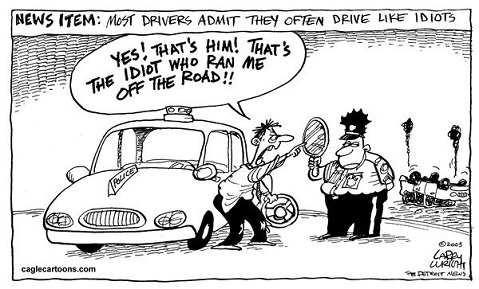‘Mature Drivers’ Refresher Class Can Help Cut Costs
New Laws and Facts About Aging Presented

“Driving unsafely often ends up sending you to the ER — at best,” warns former registered nurse and long-time Goleta resident Mary Brown. The Center for Lifelong Learning instructor, who has taught the Mature Drivers certificate course since 2002, grabs students’ attention by leaving to our imaginations what worst-case consequences might be.

Brown seeks to penetrate the shells of denial and overconfidence many 55-year-olds-and-above bring with them. I have driven for decades without serious incident, some think. I just need an update. Restless as a caged cat, she moves back and forth in front of the tables in her Wake Center classroom with a youthful energy that belies her graying hair.
Driving experience is important, but “drivers 65 and older are the second largest group involved in traffic accidents in the United States,” she tells us. “And that group is growing larger” as the boomer generation rolls into old age.
“The secret to driving safely is to be completely engaged in the process,” Brown says. Awareness of your own physical limitations, like declining vision or hearing, and making accommodations establishes the foundation. “Loss of hearing can divorce you from your immediate environment,” she notes. But so, too, can a talkative passenger, a loud radio, ear buds, and a dozen other distractions.
She’s also a realist and knows that despite sharing good driving techniques and updates on new traffic laws, most students take the class to secure a certificate they hope will reduce their car insurance cost. A show of hands confirmed that.
Brown advises that insurance companies “usually offer a 5 percent discount” to those who qualify for the course certificate, but the firm decides the discount. You have to request it, and there is no guarantee you’ll get it.
This could be a metaphor for the course: You may learn useful defensive techniques, obey all the laws, and exercise caution, and some scofflaw driver texting illegally could still smack your car. Useful as they are, mature drivers’ classes make no guarantee you won’t be in the wrong place at the wrong time.
Brown provides common-sense tips for tilting the odds in favor of the aware driver. The best precaution, no matter your age, is never mix alcohol and driving. However, studies show that seniors’ brains and bodies are particularly vulnerable to alcohol’s effects on reflexes and mental muddling. Diminished metabolism lowers seniors’ alcohol tolerance while their bodies retain it longer.
A booklet Brown prepared for her students declares that “alcohol is the main cause in about 45 percent” of each year’s total fatal traffic accidents in California. “Even one drink can make you an impaired driver,” it adds. The degree of impairment depends on factors such as physical and emotional conditions, weight, empty stomach, number and alcohol content of drinks, and length of time between drinks.
Because male bodies contain more water than that of females, gender can make a difference in alcohol impairment, according to one of the course’s main sources, the state DMV. Impairment may also be caused by medications, both prescribed and over-the-counter. “Always check labels” for side effects of drowsiness before taking the medication and driving, she urges in the booklet.
Among Brown’s other handy hints is one she called “dancing with the cars,” a common problem when vehicles meet at an intersection and drivers hesitate about going first. “Don’t insist on your right-of-way, give it to the other person,” she suggests. It helps if you gesture to the other driver to go.
Despite built-in signal lights, communication is an underused driving skill. Remember how it felt when someone turned in front of you without warning or stopped for no apparent reason? “A lot is just common sense,” Brown observes.
Some driving rules change because legislators think they will enhance the safety of roads vehicles often share with walkers and bicycle riders. A 2014 state law, for example, mandates that at least three feet of space must exist when vehicles pass bicyclists.
Other laws place what Brown calls “an absolute responsibility” on drivers to avoid pedestrians, whether they are in crosswalks or not. However, if turning right at an intersection, drivers do not have to wait until pedestrians have completely crossed over before completing the turn, I learned.
“The police tell me that if a pedestrian is more than half-way across the intersection it is okay to make the turn,” she explained in an interview.
Brown will again present one-day adult education classes for Mature Drivers (55 or over) on May 17 and June 7. First-timers take an eight-hour course, which awards a certificate valid for three years; the renewal course is four hours long.



